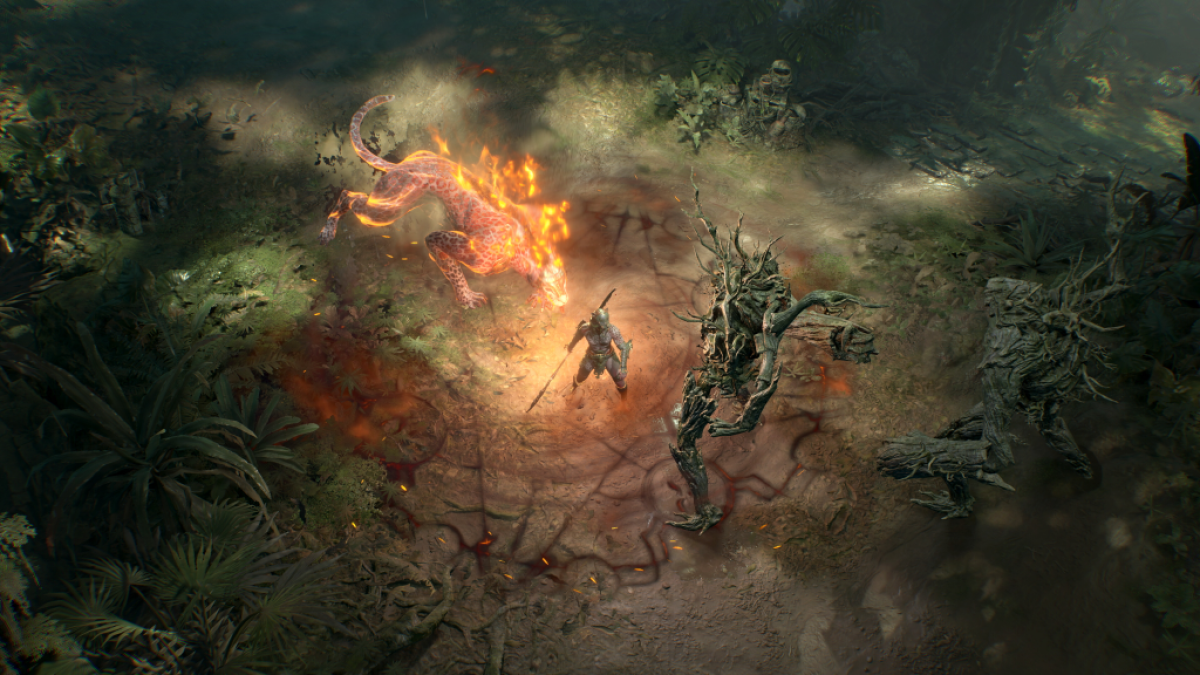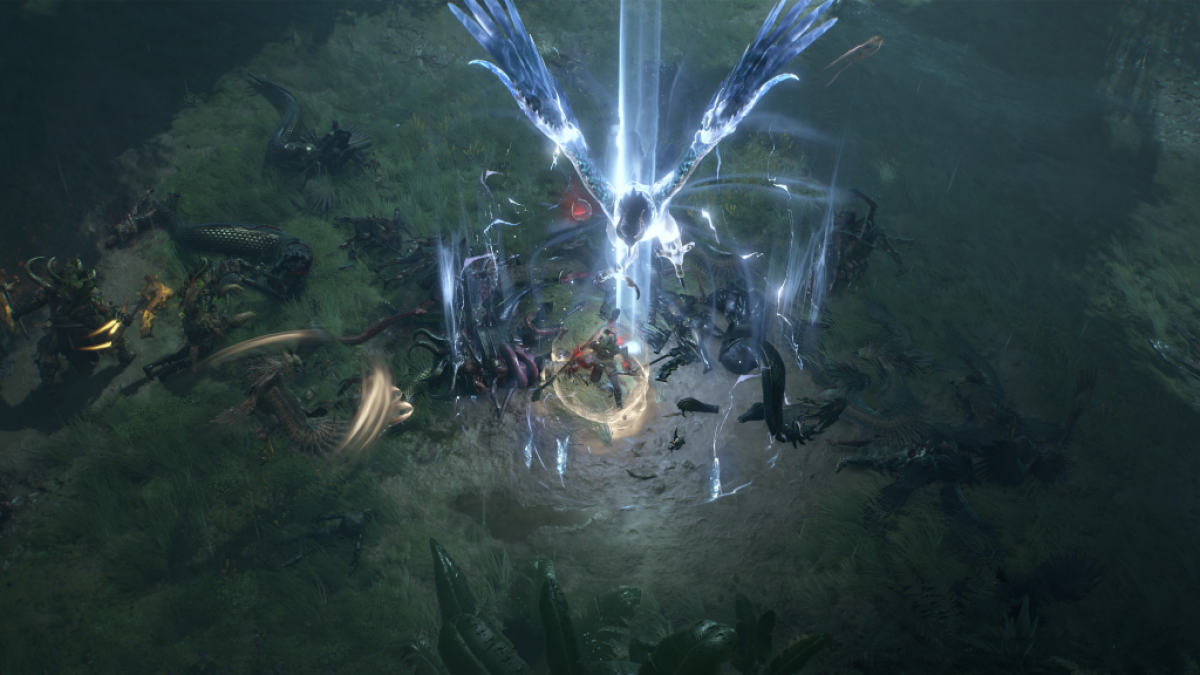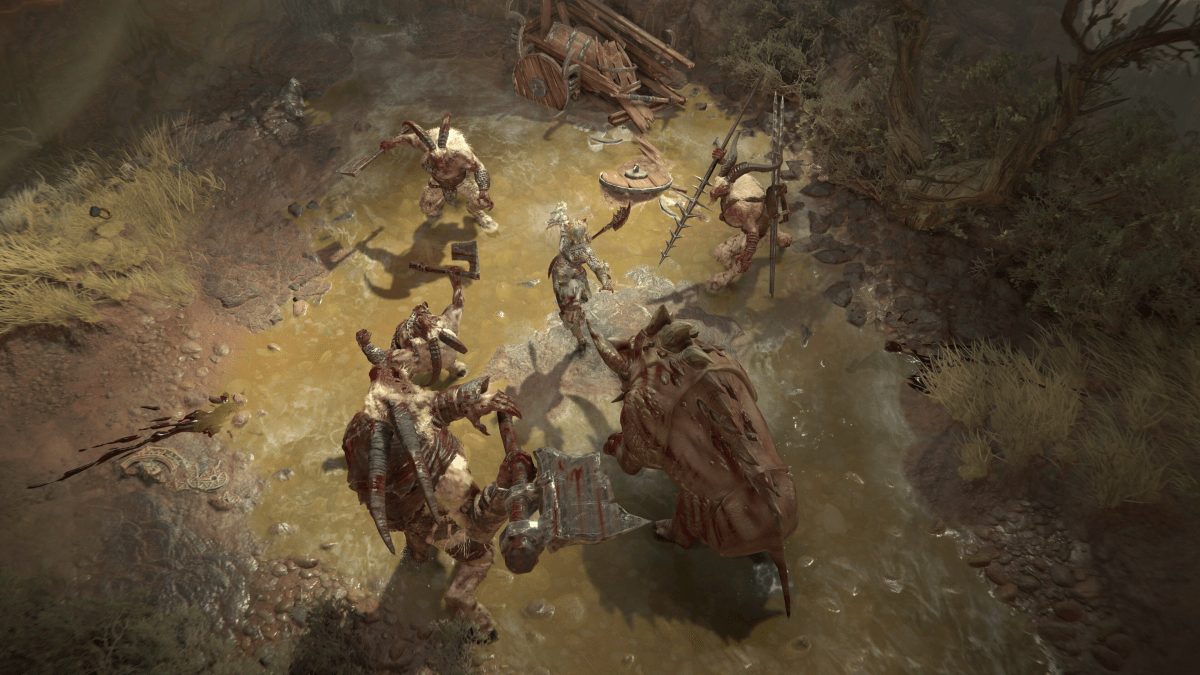Venomous snakes, overlarge and the color of sinew and raw red meat, slither over a well worn path. Flies buzz around corpses that have been claimed by lush, green jungles. Corruption grows, black tendrils seeping through green-blue waters now turned putrid. And somewhere, deep within the vines and ruins of Nahantu, a presence stirs — Hatred manifest. Which is apt, consider Diablo IV’s expansion is titled Vessel of Hatred. And while Diablo IV does draw players back to the once explored jungles of this southern continent, Blizzard Entertainment has cast a new light on this region, and used it to expand further on the MMO-lite systems that appeared in the base game.
To say that I was anticipating this expansion would be an understatement. While not the perfect game by any stretch of the imagination, the narrative of Diablo IV had me intrigued as to where the series could go next. There was the familiar strum of an acoustic guitar, the tease of the Prime Evils returning to Sanctuary in some shape or form. Vessel of Hatred builds upon these things, but not in the way that I expected. Because as a series, Diablo has always been straight forward. While the binary lines of good and evil are often obscured, you know that, at the very least, you will be fighting back against the spawns of Hell and their masters.
But instead of plunging players back into the fiery pits and the Realm of Hatred we were acquainted with in the base game, the entirety of this campaign takes place in the jungles of Nahantu. As mentioned previously, this region isn’t entirely foreign. Some of it appeared or was mentioned in Diablo II, a game that Diablo IV continues to try and channel to it’s benefit and detriment. Or what I believe the general audience, and to some extent even die-hards, remember that game being. It’s still gritty and gross. Killer flies attempt to swarm you as snakes dart at you from shallow pools of water. There are abominations that prowl within the jungle, but these enemies are very much the same that appeared in various areas of the base game. It doesn’t matter much, as what you kill isn’t as important as to how fast you kill it.

This new region is rich in culture, taking deep inspiration from Latin America. It’s in the architecture, in the clothing the citizens wear, and in the Spiritborn, Diablo IV‘s new class. Summoning strength from the Spirit Realm, the Spiritborn channels four animals — well, one very large insect and three animals if we’re being technical. You can call upon the Rezoka, the jaguar, to deal fire damage in fast, swiping slashes, Kwatli, the eagle, to launch yourself in the air and slam down on enemies to electrify them, crush them with the raw strength given to you by Wumba, the gorilla, or spew poison at your foes with the power of Balazan, the centipede.
Overall, the Spiritborn is a somewhat well rounded class. I liked the option of being able to choose from four different types of damage, even if I favored the burn damage from Rezoka and the poisonous puddles provided by Balazan. Much like the Sorcerer, I felt funneled into specific builds, but I’m liable to give Wumba a shot once the game releases in full. As it stands, the Spiritborn is a nimble, close-range fighter that excels best when you’re mashing your dodge button to weave in and out of combat. It reminded me most of Rogue, a class that I previously loved, but have come to otherwise abandon in the late game for the less involved Necromancer. While the Spiritborn is no doubt exhilarating to play, it isn’t my speed. But those that love fast and frenetic movement will absolutely enjoy this class, and based on what I played and saw (since Blizzard Entertainment allowed us to group up with other reviewers given access to the game ahead of launch), it seems like it’s capable of doing an incredible amount of single target and AoE (Area of Effect) damage.
I ran through The Undercity, one of Diablo IV‘s new ways to level, which is effectively a series of small dungeons that require you to gather essence from random spawned fonts, while killing enemies to build up time so you don’t get kicked out before defeating the final boss and reaping your rewards. You can also offer tribute to increase the amount of rewards you get and what kind. It’s a more effective way of grinding out gear and materials than Helltides, for example. My Necromancer was more than strong enough to blast through The Undercity on his own, even on the higher Torment difficulties, due to some good luck regarding a few uniques I picked up, but paired with a Spiritborn, we were speedrunning these micro-dungeons with incredible efficiency.

And in the end game the Spiritborn continued to shine, as Diablo IV has edged closer and closer into becoming an MMO-lite. Yes, the base game allowed for you to see players scurrying about in the world, and world quests were kind of a thing that existed but never quite caught on. But Vessel of Hatred takes this a step further with a new end-game dungeon The Dark Citadel. Unlocking it is a chore, and I’m not sure how much I like the idea of weekly rewards tied to what is effectively a World of Warcraft raid appearing in the ARPG. Blizzard Entertainment has also added a Party Finder into the game, which I’m sure many will be using to clear this new gauntlet of content, which cannot be tackled alone. Which is probably for the best, because The Dark Citadel is hard. Like, really hard. This in combination with how the campaign ended, leads me to believe that we’re going to get a lot more expansions. And probably not far spaced apart.
Vessel of Hatred continues not some time after the ending of Diablo IV. Lilith has been slain, and her father, Mephisto the Lord of Hatred, has been imprisoned in a stone. If you’re familiar with the Diablo series, you’ve seen this song and dance before. Because for some reason, this seems to be the only solution to imprisoning beings of great and terrible power. The player character is on the hunt for Nyrelle, a young girl who more or less made the decision to seal said Lord of Hatred into the stone, and it now threatens to overcome and wholly corrupt her. Again, the game is not subtle about it’s various metaphors and imagery to the very end. And brutality in Diablo IV comes in handfuls in what feels like an attempt to further distance itself from the maligned Diablo III, which arguably had some of the darkest lore the series has had to date.
Violence and death are plentiful because it must be so, the narrative must remain cynical and cyclical even with small rays of hope desperate to shine through. It is what fans want, but it doesn’t do the game any favors. I’m not sure if I was more tolerant of it in the base game because I had a deep desire for a new Diablo game, or if I just really loved Lilith. In Vessel of Hatred it feels wanton, necessary because this is what the brand is now. A man is flayed open, driven mad, because that is just the way the world is. People are driven to the brink in the wake of Reaper of Souls, pushed further to the edge because of Lilith’s promise of free will and our denial of it. Sacrifices are made out of a desperate sense of self-preservation, but for what?

I won’t spoil the end of the expansion, but it was so on the nose that it nearly made me laugh. I have a clear idea of what could happen, but given how abruptly it ended and how far away we seem from actually fighting a Prime Evil, I’m not sure when we’ll get there. I’m not even sure if I’m interested at this point. But Diablo has always been good at sucking me back in through it’s seasonal content, that continues to introduce new mechanics. I will give the development team that, in that Vessel of Hatred is the product of these hit or miss seasonal cycles, pulling what players were most receptive to, and just keeping it in. However, I’m not too keen on some adjustments made to unlocking the aforementioned end game content. I’m just glad I have a high level character to blitz through it and unlocking it before jumping into the next season, because I know I will.
The Diablo IV Vessel of Hatred expansion has me torn. I love a lot of the new changes, and I really wanted to say that I loved the story, but I don’t. Since I’m largely someone that does play a game for it’s narrative, it’s strange to be on the other side of that. Now I’m in it for the gameplay, the number crunching, finding the most effective build to run dungeons ad nauseam while listening to whatever post-hardcore song shuffles through the playlist I’ve constructed overtime just to keep me going. If anything, I suppose it’s fun, and players looking to sink their teeth into more engaging content will have a good time. I just wish I loved it more.
Diablo IV is available right now for PS4, PS5, Xbox One, Xbox Series X/S, and PC. Vessel of Hatred will release on October 8, 2024.
Become the apex predator of the jungle as the all-new Spiritborn class. Expand your map to journey into the new region of Nahantu in search of Neyrelle. PC version reviewed. Review copy provided by company for testing purposes.
Diablo IV Vessel of Hatred leans further into becoming an MMO-lite, adding more multiplayer end-game activities to keep content feeling more varied. However, the narrative is heavy-handed and doesn't do Diablo IV any favors.
- Nahantu looks lovely and expands the map, even if there isn't much variety to enemy type.
- Vessel of Hatred adds more ways to obtain Uniques and Legendaries, which breaks up the monotony of the end game.
- The Spiritborn feels like an excellent addition to the otherwise small roster of classes.


Published: Oct 4, 2024 12:00 pm